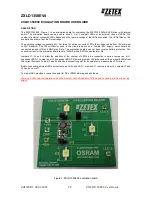
6
AN1248.1
May 30, 2006
Driver Tests
Ensure that the “DZ1/DE1 (DY)”
(14)
jumper is in the “LOW”
position to engage the 50
Ω
term resistor, connect the
generator to the “DZ1/DE1 (DY)” BNC, and set the swing for
0 to 3V. Monitoring test points “TP18” (input) and “TP5”
(output) with a scope, allows the Tx prop delays, skews, and
transition times to be measured.
To measure the “loaded” driver performance, simply remove
the “J10”
(2)
jumper, and connect the “A1/Y1_LB”
(5)
jumper,
which connects an Rx input, including its 5k
Ω
pull-down, to
the driver output.
To measure the Tx output enable/disable times to/from a
high output state, start with the previous jumper
configuration and move the “(DEN)”
(8)
jumper to the “LOW”
position to engage its 50
Ω
term resistor. Connect the
generator to the “NC (DEN)” BNC, and set the swing for 0 to
3V. Monitoring test points “TP9” (input), and “TP5” (output)
with a scope allows the enable and disable times to be
measured. Note that some form of output termination
resistor must be used to pull the disabled output to a known
state; installing the “A1/Y1_LB” jumper is the easiest
solution.
Evaluating Driver and Receiver Combined Performance
Performance through a cascaded Tx and Rx can easily be
evaluated, utilizing the external loopback function. Insure
that the “A1/Y1_LB
(5)
jumper is installed, that the
“(DEN)”
(8)
and “(RXEN)”
(11)
jumpers are set to the “VH”
position, and that the “DZ1/DE1(DY)”
(14)
jumper is in the
“LOW” position. Connect the generator to the
“DZ1/DE1(DY)” BNC, and set the swing for 0 to 3V.
Monitoring test points “TP18” (input), and “RB1 (RA)”
(output) with a scope allows evaluation of the total Tx and Rx
performance. In this configuration, the Tx output line
connects to an Rx input line, so the data driven on the Tx
input (DY) appears at the Rx output (RA).
Evaluating the Logic Supply (V
L
) Function
The ISL41387 includes a V
L
pin that powers the logic inputs
(Tx inputs and control pins) and Rx outputs, regardless of
protocol selection. These pins interface with “logic” devices
such as UARTs, ASICs, and
μ
controllers, and today most of
these devices use power supplies significantly lower than
5V. Connecting the V
L
pin to the power supply of the logic
device limits the ISL41387’s Rx output V
OH
to V
L
, and
reduces the Tx and control input switching points to values
compatible with the logic device’s output levels. If the logic
device is also powered by 5V, then the V
L
pin should be
shorted to the V
CC
pin.
Removing jumper “V
CC
-V
L
”
(16)
, and connecting a new
power supply to the “V
L
” banana jack allows the user to
evaluate this function. V
L
can be anywhere from V
CC
down
to 1.65V, but the input switching points may not provide
enough noise margin when V
L
< 1.8V. Table 2 indicates
typical V
IH
and V
IL
values for various V
L
settings so the user
can ascertain whether or not a particular V
L
voltage meets
his needs.
To evaluate the V
L
impact on Rx V
OH
, vary the V
L
voltage
while monitoring a high Rx output. To evaluate the V
L
effect
on input switching points, remove the “VL-VHIGH”
(17)
jumper, connect a new supply between the “VHIGH” and
“GND” banana jacks, set the V
L
supply to the desired
voltage, move the jumper of the input to be tested to the
“VH” position, and vary the “VHIGH” supply to determine the
switching point.
Jumper Definitions
The jumpers used to evaluate the ISL41387 are:
J-A1
(1)
-
Connects A1 input to GND through a 50
Ω
resistor.
J10
(2)
-
Connects A1 input to the RXBIAS jack.
J9
(3)
-
Connects B1 input to the RXBIAS jack.
J-B1
(4)
-
Connects B1 input to GND through a 50
Ω
resistor.
A1/Y1_LB
(5)
-
Loops output Y1 back to input A1.
B1/Z1_LB
(6)
-
Loops output Z1 back to input B1.
J-A2(485/232)
(7)
-
“LOW” sets the IC to RS-232 mode;
“VH” sets it to RS-485 mode.
J-(DEN)
(8)
-
“LOW” disables RS-232 or RS-485 Tx outputs;
“VH” enables all Tx outputs.
J-SPB
(9)
-
Used with “SLEW” to set the RS-485 Tx data
rate (see Table 1).
J-RXEN1
(10)
-
“LOW” enables all RS-232 or RS-485 Rx
outputs; “VH” disables Rx outputs (iff J-(RXEN) = “LOW”).
J-(RXEN)
(11)
-
“LOW” disables all RS-232 or RS-485 Rx
outputs (iff J-RXEN1 = “VH”); “VH” enables Rx outputs.
J-(ON)
(12)
-
“LOW” places IC in “special features” mode
(loopback, SHDN, etc.); “VH” sets IC for normal operation.
J-DY1(DZ/SLEW)
(13)
-
“LOW” sets the Z Tx input low in
RS-232 mode or selects the slew rate limited data rates in
RS-485 mode; “VH” sets the Z Tx input high in RS-232 mode
or selects the 20Mbps data rate in RS-485 mode.
J-DZ1/DE1(DY)
(14)
-
“LOW” sets the Y Tx input low in
RS-232 or RS-485 Modes; “VH” sets the Y Tx input high in
either mode.
TABLE 2. V
IH
AND V
IL
vs V
L
FOR V
CC
= 5V
V
L
(V)
V
IH
(V)
V
IL
(V)
1.65
0.79
0.50
1.8
0.82
0.60
2.0
0.87
0.69
2.5
0.99
0.86
3.3
1.19
1.05
Application Note 1248



























